Jusant is a climbing adventure that follows the journey of a nameless protagonist to the top of a colossal spire on an urgent mission. The story begins with the player character wandering out from a desert. I deduce from the broken ship frames rusting across this wasteland that it is the remains of an ocean that slowly dried away along with all other water on this unidentified world. Where the player character has come from and what hardships they endured crossing the desert is a mystery, but their destination is apparent: The Tower, a massive column of earth and stone rising up thousands of feet from the desert floor. Over about a five hour self-guided adventure, I steer the player character to the top of the Tower using a unique control scheme that gives me individual control over each of their hands.
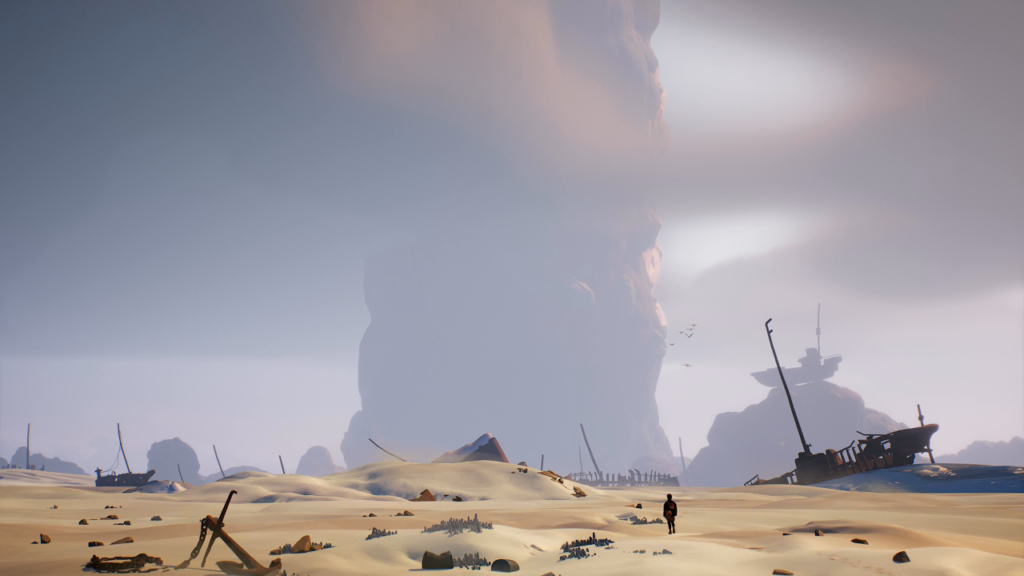
Jusant is driven totally by its unique climbing mechanics. The player character comes across numerous vertical surfaces they must ascend to reach the top of the Tower, each affixed with dozens of tiny handholds that wind their way up to the next landing. I can direct the player character to grip and release the fingers of their left and right hands by pressing and releasing the left and right triggers of a standard controller. Once they grasp a handhold with one trigger, I can use the joystick to guide their opposite arm to the next grip with the other trigger, then release the first trigger to reach for the next handhold. This process bounces back and forth until the player character reaches the top of their current obstacle.
At first my ability to manipulate this control scheme is awkward. The player character falls a few times. Other times, I forget to release a trigger and I wonder why they are stuck to the wall like a tiny lizard spotted by a hungry bird. I soon acclimate, slipping into a groove where I press and release triggers in smooth succession, guiding the player character up the Tower with the confidence of an Ubisoft Assassin clambering up the side of a monument.
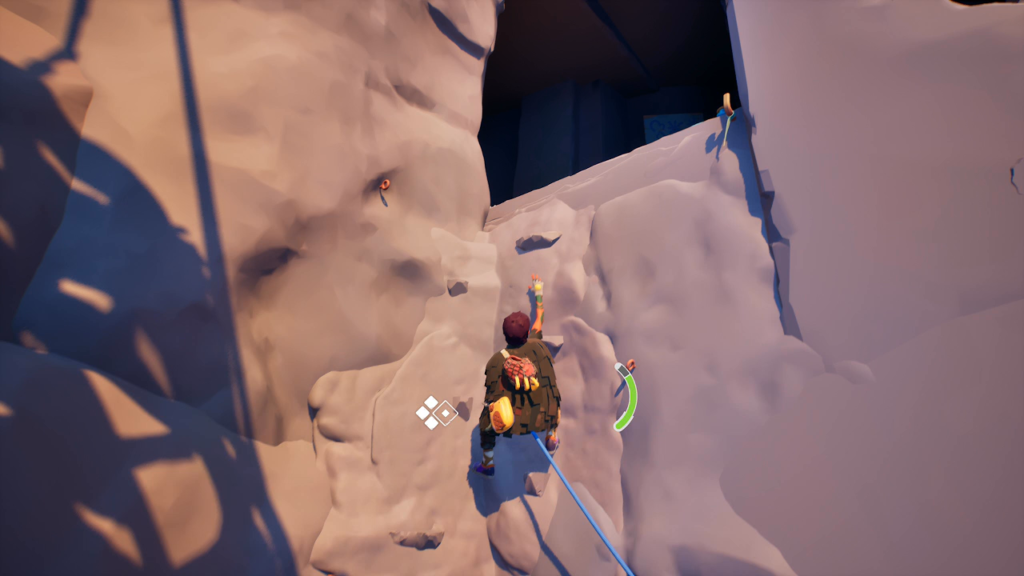
Despite the player character’s treacherous ascent and my initial struggle with Jusant’s unique control scheme, at no point do they die. This is thanks to their safety rope and the automatic winch attached to their belt.
At the base of nearly every ascent there is an anchor where the player character will mount their rope. This process is automatic and seamless, not interrupting my control for even a moment to weigh Jusant down with overwrought animations. This anchor ensures that even if the player character tumbles off a cliff face, they will not fall to their death hundreds or thousands of feet below. They will fall to the bottom of the rope, then use the winch on their belt to reel themselves back up to the anchor.
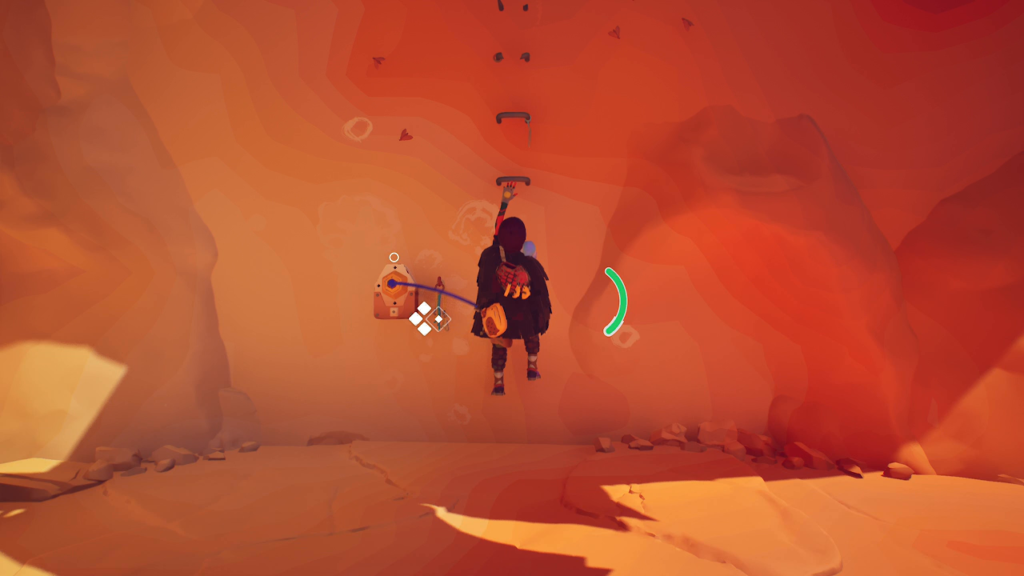
The safety rope is so pivotal to Jusant’s design philosophy that the player character isn’t allowed to fall from edges if they are not mounted to their rope. On the occasional moments I want the player character to go down instead of up, they must first be secured to an anchor. When unsecured they behave as though an invisible barrier shields every platform’s edge, refusing to take a step further no matter how hard I hurl them against it. Even if the player character somehow does fall onto a hard surface, they suffer no harm. Jusant is uninterested in ideas like health meters, extra lives, deadly falls, or hostile monsters. It offers a gentle, thoughtful, and methodical adventure.
In addition to the anchor at the base of each ascent, I can direct the player character to add new anchors midway up their climbs using up to three pitons. These act as makeshift checkpoints; if the player character misses a handhold or mistimes a jump, instead of falling all the way back to the bottom of the ascent, they can wind their winch back up to their last piton. Sometimes pitons must also be used to let the player character swing to a distant handhold or even take leaps of faith to a far-flung platform. The only limiting factor to pitons is the amount of rope the player character carries. Zig-zagging between too many pitons across the Tower’s surface will stretch the rope to its limit and prevent the player character from climbing further. When this happens, the ascent must be attempted again from the first anchor.
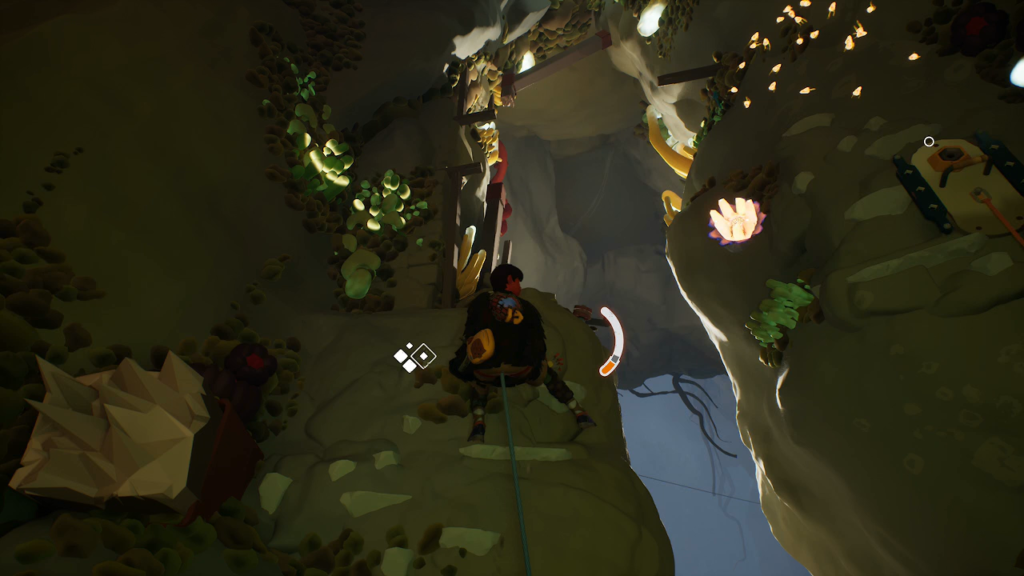
There is a final climbing factor of which I must remain aware. Stamina is represented by a meter that predictably drains with every movement the player character takes while climbing a wall. More dramatic movements like leaping between handholds take greater amounts of stamina. If too much of the meter is expended to allow these big moves, the player character can take a break, hanging motionless from a handhold for several seconds. This replenishes the meter, but also lowers its cap until they set foot on solid ground again. This system is effective at representing the player character’s growing exhaustion during their climbs. They can take a break to give them a boost for the next big movement, but taking too many breaks ultimately hinders their progress. Progress up the Tower needs to be constant and deliberate, finding a careful middleground between caution and zeal.
Despite these complicated interlocking systems and my initial fumbling with the trigger controls, I find the climbing in Jusant to be gentle and approachable. Only once in my particular journey up the Tower does the player character reach the limits of their rope and have to start that ascent over from its beginning. They never exhaust their stamina. The climbing systems find an enjoyable sweet spot between complication that captures a feeling of authentic athletic skill and approachability that keeps systems simple enough to be enjoyable.
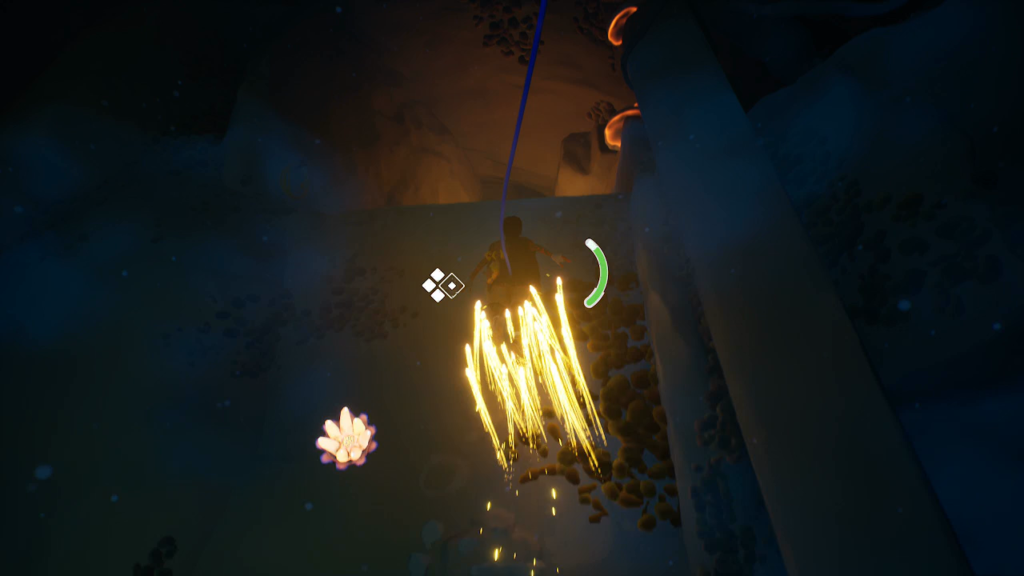
Jusant is divided into six chapters, each focused on a unique segment of the Tower and each introducing a complicating mechanic exclusive to that chapter. In Chapter 2, the player character climbs a section of the Tower at midday where direct exposure to the sun drains their stamina faster. I must help them scurry to handholds in the shadows to ensure they have enough stamina to reach the top of each ascent. Later chapters have ascents that can only be completed using swarms of skittering rock-like insects as mobile handhelds, a cloud of sparkles that launch the player character into the air, and with jumps carefully timed with massive gusts of wind. Each temporary mechanic ensures the underlying climbing foundations don’t become too boring or predictable.
What does feel boring and predictable are the artifacts the player character discovers during their climb up the Tower. Scattered among the ruins and detritus of the civilization that once sprawled across the Tower’s side are the objects they left behind. The player character comes across altars and frescos that glow with mysterious energy as they draw nearby. They find seashells that, when held to their ear, magically reproduce the sounds of the room where they are discovered when they were still inhabited, echoing the sounds of running water, a busy port, or giggling children. They can find cairns, stacks of rocks left behind by previous visitors to the Tower, and the player character can add their own stone to the top to declare to future visitors, “I was here.”
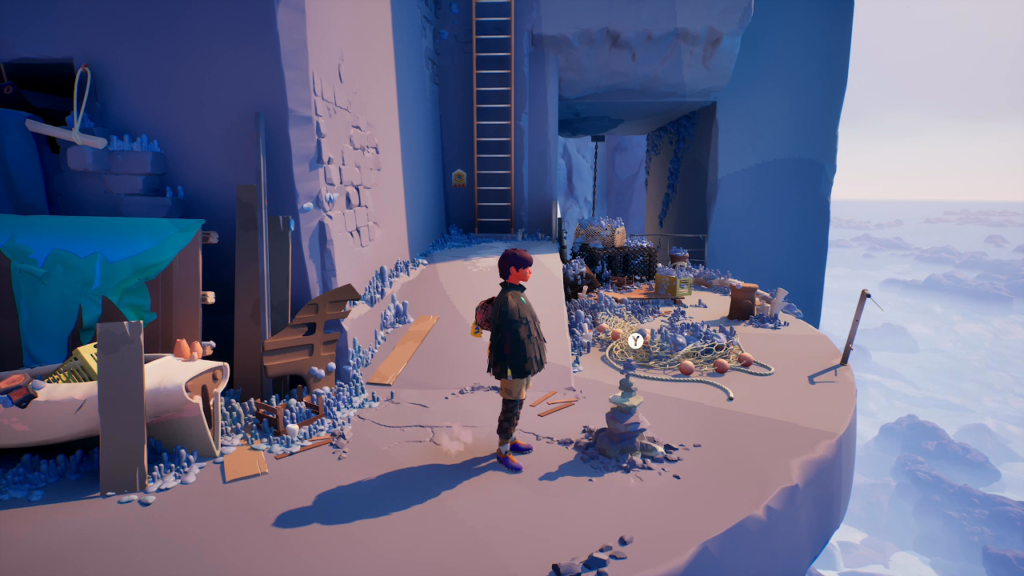
I struggle with these artifacts because I cannot dispel the feeling they are cynical, of a quantity and variety to function as videogame collectibles and not meaningful additions to the Tower. They are there to pad Jusant’s length, to give that extra bit of work for one hundred percent completion. They encourage me to linger in each area in spite of the player character’s urgent mission and to return after the credits to find what I missed. They feel like they exist to reach an achievement quota more than to enrich the world of the Tower. They are a distraction, and not a welcome one.
Despite my misgivings about these collectibles, I cannot deny that others provide enough glimpses of the Tower’s history that I am able to puzzle them together into a vision of a detailed world. Most of the best pieces of information come from the writings left behind by the Tower’s former inhabitants.
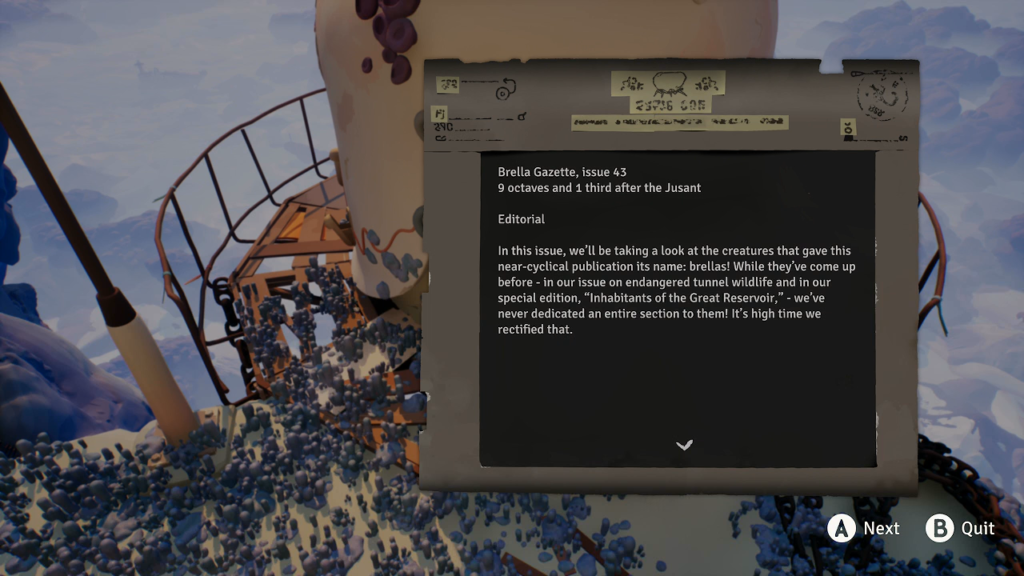
On the abandoned doorsteps of many Tower dwellings, the player character finds back issues of a newsletter called the Brella Gazette. Their writer describes the process of delivering them, and I imagine them climbing up and down the Tower between settlements much as the player character does, making the connection between the Tower’s inhabitants into their career. Some of the newsletters describe the useful functions of the world’s wildlife, like the Chocos, brown and rotund mouse-like creatures who skitter into cracks in the wall when the player character draws near them. Other newsletters only describe the process of writing the newsletter, as though its writer continued writing it for lack of anything else to do. I wonder if their subscribers ever read them. I wonder if they were indeed subscribers, or just the compulsive project of a lonely writer in a dying world.
I find journal entries written by Bianca. She was a young woman who lived in Low Tide, the village at the Tower’s bottom where the player character begins their ascent, and she journeys to the Tower’s top on a quest of her own. It’s from Bianca I learn that expeditions were sent out from Low Tide into the Salt Flats, the desert the player character treks in from, and she compares her own journey back up the Tower to those travelers. They went into the Salt Flats in search of water. She climbs the Tower to look for the same. All evidence of this world’s state is both groups failed.
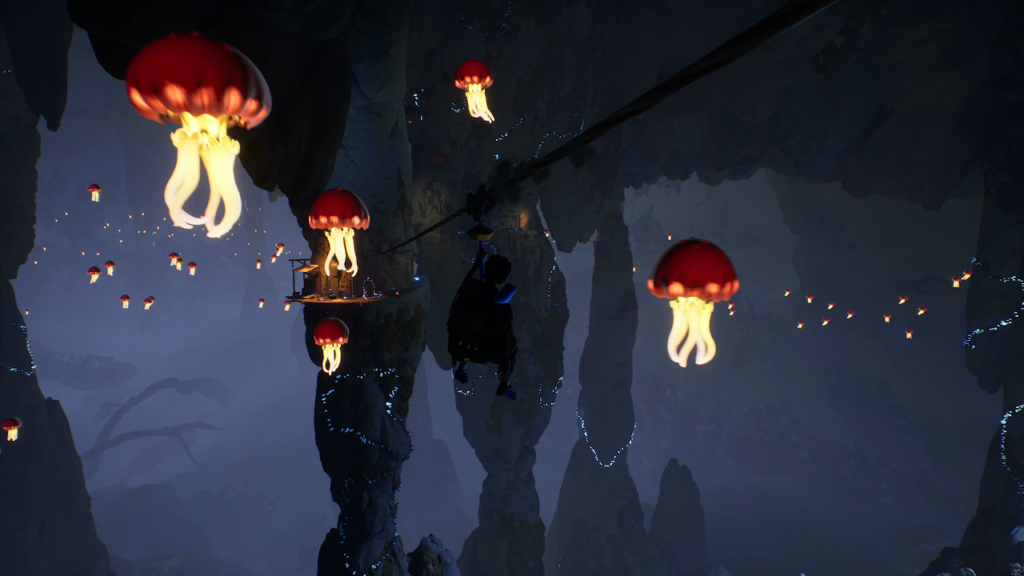
Everywhere the player character travels, I see the remnants of a civilization that slowly died of thirst. As the water levels sank lower and lower, the world’s inhabitants sank with it, following the water that was their livelihood, establishing settlement after settlement, until they reached Low Tide at the ocean floor and the water completely disappeared. The player character travels through a settlement carved into the Tower’s interior, finding an account of a labor strike that demanded equal access rights to some locks built into a canal. The locks are now dry and the canal abandoned, filled with the skeletons of tiny boats. Another letter writer expresses wariness at leaving their home, of the unnaturalness of living a “horizontal” life; these people lived on the Tower’s side for so long that climbing felt more natural than walking. They lived an alien life I can observe, but not really understand.
Aside from its climbing design, the world of the Tower and its extinct inhabitants is Jusant’s particular strength. Its particular weakness is its player character. I never really know who they are or where they came from. Are they a descendant of the expeditions who traveled into the Salt Flats? Where did they obtain their blue tattoos that glow with mystical light at key points on the journey? As they climb the Tower, they blow a series of massive horns. Who built these horns? What are their functions? For all the dozens of newsletters, journal entries, and miscellaneous notes the player character discovers climbing the Tower, I find few clues to answer these questions. They are inscrutable in a way that is frustrating and not enticing.
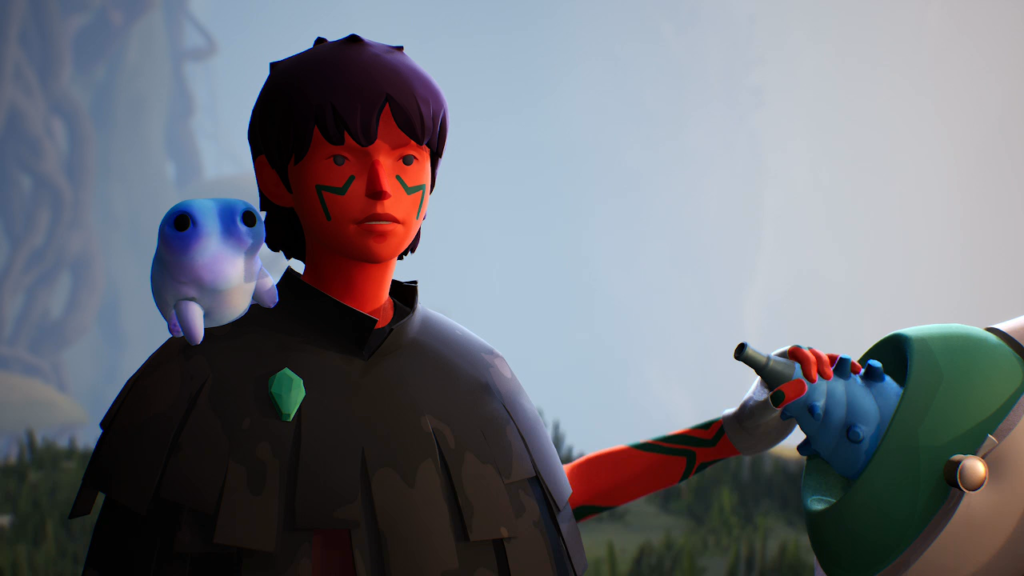
Only slightly less opaque is the creature that accompanies the player character on their journey. Referred to as the Companion, it’s a tiny blue critter, something like a cross between a dog and a frog, and it squeaks pleasantly when it interacts with the player character. It spends most of the climb sequestered in a shell strapped to the player character’s back, occasionally emerging to use its unique powers. With the press of a button, it lets out a cry which causes plants to grow with astonishing speed, freezes certain creatures in their paths, and other seemingly random behaviors that prove surprisingly useful during the player character’s climb.
I find a few notes about the Companion’s species which give me some idea of what it is, where it came from, and what its purpose is. Its relationship with the player character—how they met, the exact limits of their bond, and just which of the pair is really in charge—is completely hidden.
Ultimately, the player character’s and the Companion’s disconnection from the Tower prevent me from fully embracing their mission. They are wraiths passing through a dead world, bringing salvation that comes too late to save the people who hoped for it. As conduits for engaging with Jusant’s climbing mechanics and for understanding the history of the Tower, they are effective. As interesting characters who compel me to see their journey to completion, they are ineffective. I ultimately feel nothing for either of them. This drains the drama from the climax, built around a relationship I am never given an understanding of beyond a few affectionate tickles and some adorable cooing.
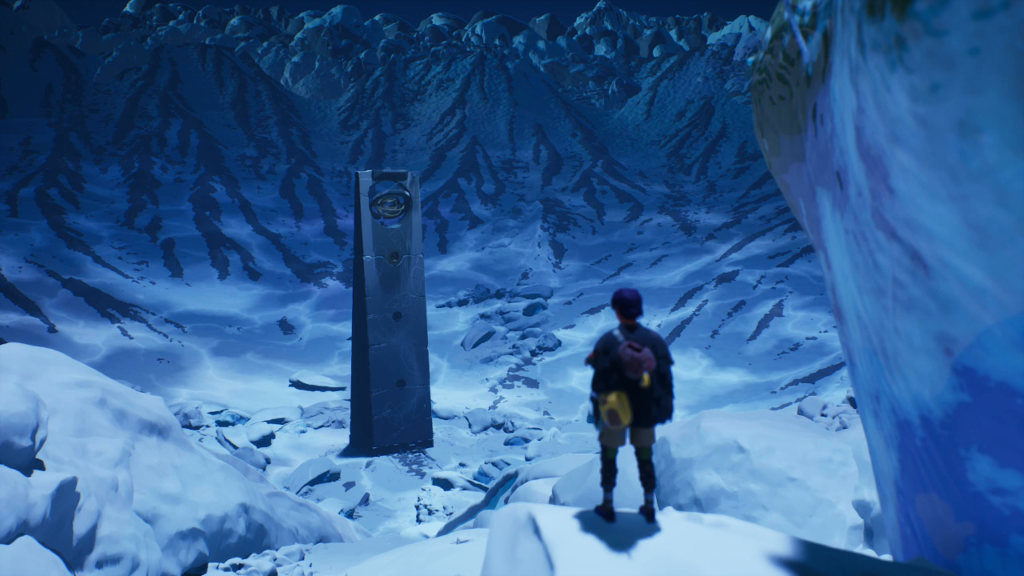
Jusant has moments that keep me interested and engaged, but ultimately is non-essential. Its climbing mechanics draw me in at first. They are unique in the videogame ecosystem, feeling detailed without becoming overcomplicated and entertaining without approaching absurdism. After about an hour they become second nature, letting me focus more on the narrative aspects. The Tower is a brilliantly realized setting, rich with history and the remnants of long-lost characters. I only wish the player character and their Companion were as rich. I never get a sense of who they are. They feel more empty and ghostly than the extinct civilization they climb through. Jusant tries to climb to mechanical and narrative glory, but doesn’t quite endure its final ascent.